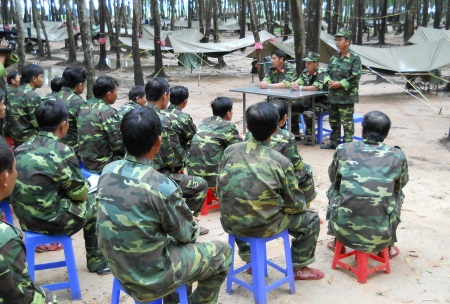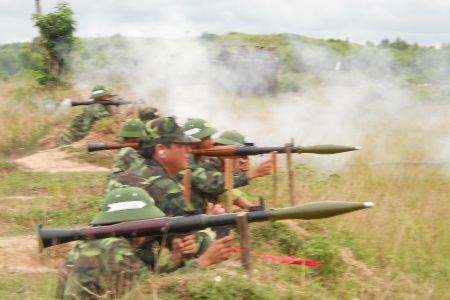Amidst the requirements for military build-up and national protection in the new situation, since April 1994, the Division 317 under the Military Region 7 has been assigned to cooperate with Ho Chi Minh city and Long An province in building, managing, and training the reserve force as well as maintaining readiness for mobilizing this force when necessary. In the process, a part from advantages, the Division has been confronted with numerous difficulties due to the large area. Reservists are diverse; the reserve force’s structure is frequently changed; the facilities and barracks are insufficient and degraded. Against that backdrop, to fulfil the mission, the Division’s Party Committee and Command have taken various measures synchronously for building and training the reserve force and achieved the encouraging results.
 |
| Sr. Col. Nguyen Van Rat meeting the reserve force prior to an exercise |
First of all, the Division’s Party Committee has focused its leadership on the work of education to raise cadres and soldiers’ awareness and responsibility towards the building of the reserve force. The Division’s Party Committee and Command always pay special attention to this work as the awareness of a section of cadres and soldiers towards the building of the reserve force is insufficient; some of them even think that working in reserve units will reduce the chance for promotion. To deal with those issues, the Division has stepped up the work of propagation and education to render cadres and soldiers fully aware of the Party’s guidelines, the State’s law, and higher echelons’ resolutions and directives on building the reserve force. Focuses of this work have been placed on introducing the Ordinance on the Reserve Force, clarifying the role of the reserve force in the guidelines on building the all-people national defence, the Military, and the defensive zones. To make this work effective, the Division has directed its affiliates to diversify forms and methods in accordance with each group of troops, especially young and B-frame cadres and cooperate with local authorities and military offices in educating and encouraging reservists. In addition, the Division has enhanced all-level party committees and commands’ leadership and direction over the work of reserve force, set the typical examples among cadres, soldiers, and reservists, effectively implement the 12th Politburo’s Directive 05-CT/TW and the Central Military Commission’s Directive 87-CT/QUTW on studying and following Ho Chi Minh’s ideology, ethics, and lifestyle in line with the Campaign entitled “promoting tradition, devoting talent, deserving to be Uncle Ho’s soldiers” and the Determination to Win Emulation Movement. As a result, cadres, soldiers, and reservists have been resolved to successfully fulfil their assigned task.
Under the regulations, localities register and manage the reservist resources while the Division is responsible for training the reservists. Due to the reservists’ short, irregular training duration, the Division has cooperated with localities in implementing the measures to build and closely manage the reservist resources. In the past years, the Division has stuck to the motto of “coming to every house, opportunely encouraging every reservist, and understanding their circumstance, capacity, and job” in order to grasp the political quality and military professional capacity. At the same time, it has succeeded in building and multiplying the model of “self-managing” the reservists and heightening their self-awareness and self-management when they live and work in localities without taking part in their units’ training courses. It has promoted the role of B-frame cadres in managing their inferiors in localities so that those cadres could opportunely detect and report the transformations of the reservists and their families to commanders of the A-frame units as the basis for visiting and encouraging the reservists and creating a unity between units and the reservists and their families. That has also provided a basis for units to proactively consolidate their organizational structure. Moreover, the Division has assigned cadres to take part in the work of paying the reservists’ allowances in localities, inform the reservists of the situation, grasp their ideology, inspect the quantity of reservists, and encourage the reservists. To meet the increasingly higher requirements for building the reserve force, the Division has closely cooperated with local military offices in preparing the reservist resources and organizing the reserve units under the motto of “being strong, extensive, close to the area”. To handle the difficulties in ensuring the rate of several military professions, the Division has advised localities on maintaining the rate of military professions, narrowing the area properly, and organizing infantry units within each area and specialized units according to each group of communes and within each district. Up to now, all reserve units of the Division have been sufficiently staffed; 87.15% of the reservists have held the position in accordance with their military profession.
 |
| The B41 Anti-Tank Gun firing by the Division's reserve force |
In addition, the Division has focused on achieving a breakthrough in raising the quality of training the reservists. As the reservists’ age, fitness, and intellectual level are unequal, training this force will be more difficult than active units. To fulfil the targets, the Division’s Party Committee and Command have directed offices and units to proactively make comprehensive, elaborate preparations in terms of personnel, facilities, materiel, and training ground. It should be noted that great value has been attached to consolidating a contingent of cadres and maintaining the order for training A-frame and B-frame cadres at each level. It has directed its units to organize training courses for cadres with a focus on overcoming weaknesses and assign superiors to train inferiors and A-frame cadres to train B-frame cadres. Emphasis has been placed on enhancing cadres’ methods of organizing, managing, and operating the training work, their tactical skills, and their capacity to deal with the situations in training and exercises. To ensure the full strength in training, the Division has proactively cooperated with local military offices in developing and delivering the training plans to localities and reservists. At the same time, it has closely grasped the reservist resources as the basis for the organization, management, and training of reserve units; closely combined military training with political education and discipline management; attached theoretical training to practical training, with the latter playing the main role. Due to the short training duration and a rich diversity of reservists (cadres, infantrymen, and specialized cadres, etc.), the Division has directed offices and units to closely follow the motto of “basics, practicality, and effectiveness” in each training section and maintain the standard order and synchronicity right in early days of training. Units have attached great value to synchronous, specialized training and new points of the training program, organized many training sessions for their troops, and encouraged them to practise in rest hours and days off. Moreover, the Division has asked units to assign their cadres to help new reservists, organize “training teams” properly, and apply the model of “pair of reservists” so that good figure could assist the other in training. In order to ensure the quality of training, the Division has directed the all-level party committees and commands to further inspect the training work, closely organize contests and practically, objectively assess the results of each training section, and fight against all signs of greed for the achievements in training only. In 2018, all reservists passed the political exam, 78.25% of them got distinction and credit; 100% of the reservists passed the military training exam, 75.6% of them got distinction and credit.
Due attention has been paid to the work of Party building within the reserve force by the Division. The Division’s Party Committee and Command have closely cooperated with local party committees, authorities and military offices in assigning the reservists who are party members to hold key positions with a view to establishing party organizations within the reserve force. Party committees and commands of offices and units have advised party committees of localities, offices, and factories on initiating new members into the Party within the reserve forces as well as strictly maintaining the order for Party meetings and party member education and management in localities and enterprises. Consequently, cadres and party members within the Division’s reserve force have had rather full political awareness and promoted their exemplary role in performing their task when receiving the orders for mobilization, training, and exercise. Up to now, the rate of party members within the Division’s reserve force has been 7.45%, and their political quality has been increasingly raised.
Ensuring policies and entitlements for the reservists is an important task and directly impacts on the results of the building and training of the reserve force. To deal with the issue of untimely payment of entitlements for the reservists in some localities, the Division has proactively worked with each localities to ensure the policies and entitlements under the regulations and directed its offices and units to provide sufficient policies and entitlements for the reservists when they take part in training, exercises, and inspections of mobilization of reservists. At the same time, its offices and units have been required to improve the material and mental life of cadres and soldiers during training and exercises, encourage them to surmount difficulties and step up crop and animal husbandry, provide facilities for the reservists, ensure public sanitation, prevent and combat epidemics, and take care of their health. As a result, the rate of the Division’s healthy troops during training and exercises has always been above 99%, which has been highly appreciated by the Military Region 7.
The Division 317’s achievements in building the reserve force have provided an important prerequisite for it to continue successfully fulfilling this task in the upcoming time, while contributing to building the Division’s pure and strong Party Organization and a comprehensively strong Division, making it capable of all assigned tasks.
Sr. Col. Nguyen Van Rat, Political Commissar of the Division